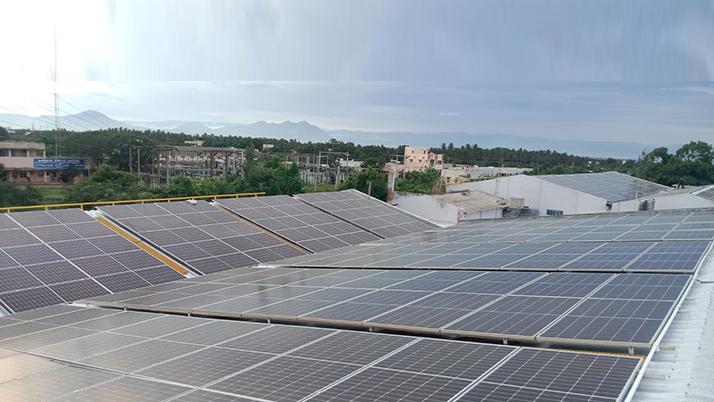Contents Top Picks
Introduction
The textile industry in India has always been open to adopting newer and more efficient technologies. Electricity is an important input that mills need today, and it has been a concern in this segment for a long time. The textile industry was among the first to adopt renewable energy in India and contributed greatly to the growth of clean energy in the country. Many set up captive power plants, windmills, and now solar power plants.
With the development of the solar ecosystem in India and knowing the many advantages of solar energy, the textile industry has embraced solar energy and has started to deploy solar systems in a rather big way. To take advantage of the huge potential of solar energy and provide efficient and cost-effective solutions, many companies (EPC operators, developers, and installers) work closely with the textile industry to deliver tailored solutions based on customer requirements. Kondaas Automation has teams specifically devoted to installing solar panels in Textile Industries and serving customers in this segment.
Industrial consumers pay a high electricity tariff, compared to other sectors. Solar power, on the other hand, is much cheaper and interestingly, the price of solar power stays roughly the same throughout the life of the solar plant (except for degradation and some replacement). escalate year by year. The textile industry is one of the most energy-intensive industries in the country.
Textile processing involves removing unwanted fiber from fabrics, finishing and printing the fabrics, and manufacturing polyester, polyester filament yarn, acrylic, nylon, and viscose fabrics. Textile processing requires a lot of hot water in the range of 40-110 ̊C at various stages of the process. The necessary heat can easily be generated through solar energy. Adopting solar heating methods will result in a savings of 383 KTOE per year. Solar power is a critical cost factor for textile manufacturers, and it can help them maintain a competitive edge. Plus, solar technology is long-term sustainable, which is a big plus.
While spinning mills account for a higher percentage of switching costs, the dyeing and fabric sectors will also benefit from their adoption. Early adopters of solar taking advantage of the currently available AD and REC benefits will establish them as a long-term differentiator. A successful proposition in business and in the marketplace. Grid power costs are expected to increase by six percent annually, and the availability of grid power is also challenging, resulting in higher usage of diesel, which in turn increases overall energy costs. It is important to have energy security in the future, and also to minimize the costs of diesel fuel currently, in order to achieve a faster payback on the investment in solar energy.
Advantages and Disadvantages of Solar Panels in the Textile Industries
According to the IBEF, about 293 global and domestic companies are expected to develop 266 GW of solar, wind, mini-hydro, and biomass-based in India in the next 5-10 years. of power generation. The initiative would require an investment of about $310 to $350 billion. Since April 2000, the industry has attracted $11.4 billion in Foreign Direct Investment. As solar energy becomes more affordable, Indian textile industries are getting more interested in using it. The textile sector contributes 14% to industrial production, 4% of India’s GDP, and 13% of the country’s export earnings. The textile industry has an advantage in harnessing solar energy through one of the following models: Indians point out, open access, captive power plants, and rooftop factories in the solar market. Textile companies should use captive solar power plants and rooftop solar energy to reduce their electricity costs, according to the Institute of Supply Management.
Here are some reasons to choose a captive or rooftop solar plant and not an open-access route
The textile business operates year-round and the energy demand is always above 1 MW. The textile industry in India pays a high rate on energy charges between Rs. 6.75 – Rs. 8.0 per unit. Therefore, as long as the solar energy cost remains lower than the utility tariff, it will continue to make a firm bid for these industries.
Despite regulatory measures to promote solar energy in the state, the open access route proves uncompetitive for textile industries. The high cross-subsidy surcharge creates a difference between what people pay and what they get. If the same amount of money had been spent on purchasing power from a thermal power plant, the bill would have been much higher at Rs.8. To avoid paying surcharges for solar energy, captive power plants can be used to consume solar energy.
On average, the Indian textile industry has enough space to accommodate 1-5 MW of rooftop solar or ground-mounted solar power. The cost of solar energy is low compared to other forms of energy, so it makes sense to use it to power your home. Captive solar panels offer a cost advantage over rooftop solar since they are much smaller and easier to install. One important factor to consider when investing is the one-time, high- and long-term nature of the investment. As mentioned above, textiles can accommodate 1-5 MW of power on their premises. This means that solar energy is a good choice for captive solar or a rooftop solar plant.
The falling cost of solar modules and the growing number of solar PV systems make it an ideal time to adopt solar power. The textile industry could benefit hugely from deploying solar projects on a large scale.
Kondaas Automation Private Limited is a leading provider of renewable energy solutions, with a portfolio of projects that include installations of solar panels in Textile Industries.
Selvaraja Mills; Ramya Textiles; VR Textiles; Ganesh SpinTech; RGR Spinners; Kamal Textiles; Sounder Textiles; Chitra Textiles
Click here to know more about the Installation of Solar Plants in Industries from Kondaas Automation.

